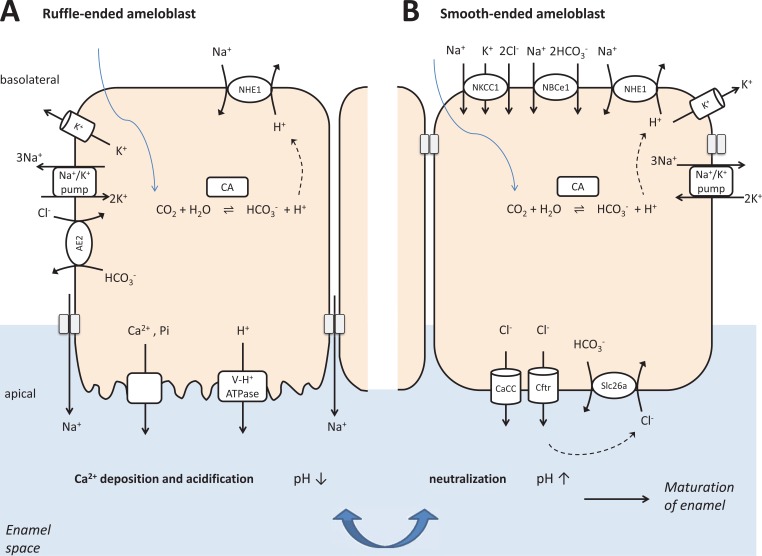Fig. (4).
Simplified model depicting bicarbonate and electrolyte secretion in ruffle-ended and smooth-ended ameloblast cells. The bottom of the figure shows that ameloblasts secrete bicarbonate to neutralize acidity in the mineralizing enamel space.
(A) Ruffle-ended ameloblast cells secrete Ca2+ and phosphate ions into the enamel space. Ca2+ is mostly taken up by the store-operated calcium entry pathway basolaterally and transported out of the cells at the apical pole by NCKX4 and NCX exchangers. Phosphate transport probably occurs via Na+-dependent phosphate (Pi) transporters. The pH is slowly decreasing during mineralization because a great quantity of protons liberated during the formation of hydroxyapatite crystals and also, probably by an active process, the apical activity of V-type H+ ATPases.
(B) Smooth-ended ameloblast cells reorganize the tight junctions to neutralize luminal acidity in the enamel space by bicarbonate. Intracellular bicarbonate accumulation is facilitated by the basolateral electrogenic Na+/ HCO3− cotransport and by carbonic anhydrase-supported by proton extrusion through Na+/H+ exchangers. The main mechanism of intracellular Cl− accumulation is probably the activity of Na+/K+/Cl− cotransporter driven by the Na+/K+ ATPase generated Na+ gradient. Apically, Cl− and to a lesser extent bicarbonate leave the ameloblasts via both cAMP activated CFTR and Ca2+-activated chloride-channels. Bicarbonate can also be exchanged to already secreted Cl− at the apical side by SLC26A exchangers. The cyclical changes from ruffle-ended to smooth-ended cell morphology and the ability to modulate pH in the enamel space ultimately allow the continuous expansion of hydroxyapatite crystal formation, to reach an extremely high level of mineralization.

